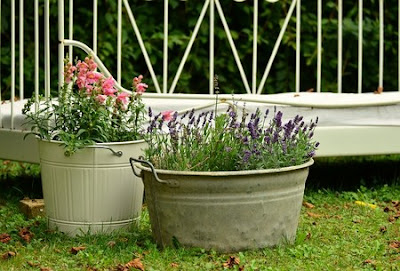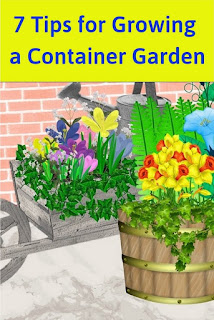Container gardens are an easy way to have a garden if you don’t have a backyard. Even if you do have a backyard garden, using pots to grow more is a nice addition to the patio and will give you more herbs and vegetables.
Pots and Containers
First, you need to get some pots and getting the right pots or containers will help grow and maintain the plants properly. Here are some of the containers you can use for a container garden and some tips for each container.
- The minimum size for any container should have a diameter of between 12 and 18 inches (30.5 cm and 46 cm) and a depth of 15 inches (38 cm). The smaller the pot, the quicker it will dry out.
- Plastic containers can age rather quickly in sunlight, which really means they might not last more than three years. If looks are also important, plastic isn’t really that decorative. Otherwise, they work just fine.
- Terracotta pots are clay and the main problem is that they dry out quickly. You need to pay attention to the dirt and the plants since you might have to water them every day and maybe more than once a day depending on your weather.
Terracotta pots are very good in that they breathe and let water drain out instead of pooling at the bottom of the container. You can buy terracotta pots already sealed which helps them last longer. This doesn’t mean waterproof, you don’t want that since they have to breathe.
 |
| Rfarmer (CC BY-ND 2.0) |
Soil
Don’t just get some shovelfuls of backyard dirt. Regular garden dirt doesn’t work well for container gardens. For container gardening, you need better soil.
A soil that drains nicely but also retains the moisture. You can buy a commercial potting soil mix and plant right into that soil or combine this with compost. You can make your own potting or container soil by starting with 2 parts peat moss, 1 part sterilized soil and 1 part perlite.
There is also something called a soil-less potting soil that you can buy. They do not contain any soil. They are made with mostly peat moss with perlite and vermiculite. The advantages are that they are sterile, retain water longer and are lighter making the pots easier to move.
Since there are no nutrients in this you will need to fertilize regularly. You can start seeds in this soil-less soil, which could be better than potting soil since it doesn’t contain the fungus or pathogens that regular soil does.
Plants
Almost any plant that you can plant in a regular garden can be planted in a container. Tomatoes, beans, and peppers will need supports. About the only plants that wouldn’t work very well would be large vegetables such as squash plants. Herbs work great as well.
Watering
If you live in a dry climate and with the intense sun along with dry winds, the soil in these pots can dry out very quickly.
Check the soil by putting your finger in and if it’s dry down to about the first knuckle on your index finger, water. This usually works, but if it's damp in the morning it can be very dry by early afternoon with the leaves wilting. The smaller the pot the quicker it will dry out. Vegetables like tomatoes need even watering. Pots need to be checked often, especially when the weather is hot and dry.
You could buy a moisture meter. You insert this into the dirt and it lets you know if the plant needs watering. Putting mulch on top can help keep the plants from drying out too quickly. Different plants have different water requirements. Plants can also get a disease and or die from too much watering just as easily as they can from under watering.
Fertilizer
The extra watering that is needed for plants in containers also washes out the nutrients more quickly. The roots that are contained cannot continue to grow out and search for more nutrients in a pot so you need to add nutrients.
Different vegetables need different nutrients. Leafy vegetables like lettuce and greens need a lot of nitrogen to grow all those leaves. But if you give too much nitrogen to tomatoes and other vegetables you might get a lot of leaves and no flowers to turn into tomatoes.
You can use organic, chemical, dry or liquid fertilizer. Organic releases are slower than chemical. Just make sure you follow the instruction since too much can burn your plants. Many people fertilize only using  fish emulsion, which is a nice easy organic fertilizer that will not burn or overfeed your plants.
fish emulsion, which is a nice easy organic fertilizer that will not burn or overfeed your plants.
Sunshine
Most vegetable plants need at least 6 hours of direct sunlight. Lettuce, broccoli and spinach like some shade or they will bolt. Containers make it easy to move around and have them in direct sun and also move them out of the way of a possible storm.
Supports
You will need to support some vegetables in pots just like in a regular garden. Tomatoes and peppers need support. You can put a cage around the entire pot or you can use something like  bamboo poles with
bamboo poles with  gardening stretchable ribbon around the bamboo poles. Put the supports in before you put the plants in so you don’t hurt the roots. Strong winds could knock over the pot and plants. If strong winds develop you could put the plants up against a wall or other support.
gardening stretchable ribbon around the bamboo poles. Put the supports in before you put the plants in so you don’t hurt the roots. Strong winds could knock over the pot and plants. If strong winds develop you could put the plants up against a wall or other support.


No comments:
Post a Comment